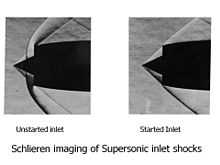Unstart

Unstart, is technical term used in supersonic aerodynamics to refer to a generally violent breakdown of the supersonic airflow.[1] Original use came about as wind tunnels were designed that could drive the airflow supersonic. 'Starting' the supersonic wind tunnel is therefore the process in which the air becomes supersonic. Unstart of the wind tunnel is the reverse process.[2] The shock waves that develop during the starting or unstart process are often visualized with schlieren or shadowgraph optical techniques.
As airplanes began to achieve supersonic flight, an inlet that delivers proper airflow to an engine became a major complicating element to aircraft design. In a simple sense, these supersonic inlets had to be carefully designed like a supersonic wind tunnel. At high supersonic speeds, (usually between Mach 2 to 3), the inlet is designed to have supersonic flow inside (or downstream) of the air inlet's capture plane. Similar to the supersonic wind tunnel, if the mass flow across the inlet's capture plane does not match the downstream mass flow at the engine, the inlet will unstart. Depending on the design, this can be violent to the airplane and pilot.[3]
The SR-71 air inlets were designed for exceptional performance but also had the risk of unstart. Another aircraft with unstart risk was the B-70 Valkyrie. The unstart problem became dramatically evident during the development of the F-107 fighter. Resistance to unstart has become an important element that defines propulsion operability and can be considered analogous to compressor stall for a jet engine.[4]
Theoretical basis
Using a more theoretical definition, Unstart is the supersonic choking phenomenon that occurs in ducts with an upstream mass flow greater than the downstream mass flow. Unsteady flow results as the mismatch in massflow can not gradually propagate upstream in contrast to subsonic flow. Instead, in supersonic flow, the mismatch is carried forward behind a 'normal' or terminal shock wave that abruptly causes the gas flow to become subsonic. The resulting normal shock wave then propagates upstream at an effective acoustic velocity until the flow mismatch reaches equilibrium.
There are other ways of conceptualizing unstart which can be helpful. Unstart can be alternatively thought of in terms of a decreasing stagnation pressure inside of a supersonic duct; whereby the upstream stagnation pressure is greater than the downstream stagnation pressure. Unstart is also the result of a decreasing throat size in supersonic ducts. That is the entrance throat is larger than the diffusing throat. This change in throat size gives rise to the decreasing mass flow which defines unstart.[5]
The choking reaction of unstart results in the formation of a shock wave inside of the duct.
Shock instability or buzz
Under certain conditions, the shock wave in front or within a duct (or pipe) may be unsteady (instable). This phenomenon is known as buzz. In these cases, the shock will oscillate upstream and downstream. Stronger shock waves interacting with low momentum fluid or boundary layer tend to be unsteady and buzz. Buzz conditions can cause structural dynamic induced failure if adequate margins are not incorporated into design.
See also
- Supersonic wind tunnel
- Sonic Boom
References
- ↑ More generally, any compressible gas flow can experience 'unstart'. But the term originated with aerodynamic research to support the development of aviation.
- ↑ Liepmann, H.W. and Roshko, A. (1957). "Flow in Ducts and Wind Tunnels". Elements of Gasdynamics. John Wiley. ISBN 0-471-53460-9.
- ↑ SR71 pilot's unstart experience
- ↑ NASA's supersonic controls research
- ↑ Anderson, John D. (2009). Fundamentals of Aerodynamics (5th ed.). McGraw-Hill. ISBN 978-0-07-339810-5.